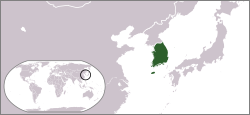Third Republic of South Korea
| Republic of Korea | ||||||||||
| 대한민국 大韓民國 |
||||||||||
|
||||||||||
|
||||||||||
|
Anthem Aegukga |
||||||||||
| Capital | Seoul | |||||||||
| Languages | Korean | |||||||||
| Government | Republic under a military dictatorship | |||||||||
| President | ||||||||||
| • | 1962–1979 | Park Chung-hee | ||||||||
| Prime Minister | ||||||||||
| • | 1963–1964 | Choi Tu-son | ||||||||
| • | 1964–1970 | Chung Il-kwon | ||||||||
| • | 1970–1971 | Baek Du-jin | ||||||||
| • | 1971–1972 | Kim Jong-pil | ||||||||
| Legislature | National Assembly | |||||||||
| Historical era | Cold War | |||||||||
| • | Established | 1963 | ||||||||
| • | Yushin Constitution | 1972 | ||||||||
| Currency | South Korean won | |||||||||
|
||||||||||
| Today part of |
|
|||||||||
The Third Republic of South Korea was the government of South Korea from 1963 to 1972. It was presented as a return to civilian rule after a period of rule by the military junta known as the Supreme Council for National Reconstruction which in 1961 had overthrown the Second Republic of South Korea. However, throughout this period the presidency was held by Park Chung-hee, who is the father of Park Geun-hye (who has been president of South Korea since February 2013), who had also been an influential member of the junta. He left his military post in order to run as a civilian in the presidential election.
Park ran again in the election of 1967, taking 51.4% of the vote. At the time, the presidency was constitutionally limited to two terms, but a constitutional amendment was forced through the National Assembly in 1969 to allow him to seek a third term. He was re-elected in the 1971 presidential election. The leading opposition candidate was Kim Dae-jung, who lost by a narrow margin.
The Third Republic of South Korea was replaced in 1972 by the Fourth Republic of South Korea under the Third Republic of South Korea's president Park Chung-hee.
The South Korean economy grew rapidly during the Third Republic. The South Korean government used the influx of foreign aid from Japan and the United States to provide loans to export businesses with no interest. It also provided financial support for industrial projects, such as the construction of the POSCO steel mill, which came online early in the Fourth Republic.
...
Wikipedia



